It’s opening night. The house lights dim; unseen dancers stand poised onstage. Months of restless rehearsals culminate in a rush of adrenaline and a hush from the audience as the curtain rises at Stevie Eller Dance Theatre.
For university students to perform a masterwork like George Balanchine’s “”Serenade”” (1935) is a rare opportunity – and one which the UA Dance Ensemble will embrace in “”Premium Blend,”” its annual production of ballet, jazz and modern dance.
More than 50 ensemble members have been rehearsing since November, learning intricate choreography and refining their technique in intensive coaching sessions. Three months may seem like a leisurely pace, but to polish the 35-minute “”Serenade,”” which will comprise the program’s first half, featuring 17 core and five principal dancers, it is nearly record time.
“”It’s almost like (training for) a marathon,”” said dance professor and undergraduate major adviser Melissa Lowe. There are four rehearsal periods per day, which typically last 4-5 hours, Monday through Friday – on top of classes.
Georgian choreographer George Balanchine is a godfather of contemporary ballet. “”Serenade”” is set to Tchaikovsky’s “”Serenade for Strings,”” considered one of the most definitive works of the late romantic era.
“”The dancers feel a chill because it’s so profoundly beautiful,”” Lowe said.
Choreography is written as a complement to the music, she said. Balanchine was careful to choose music that was so full, it would fill all the senses; he wanted the audience to be able to close their eyes and not feel at a loss for anything. “”Seeing the movement to it is just an added element,”” Lowe said.
“”This is a very free, airy, soaring kind of work,”” she said. “”It’s a feel-good piece.””
“”Premium Blend”” performance schedule
Thursday, Feb. 21 7:30 p.m.
Friday, Feb. 22 7:30 p.m.
Saturday, Feb. 23 1:30 p.m. and 7:30 p.m.
Sunday, Feb. 24 1:30 p.m.
Friday, Feb. 29 7:30 p.m.
Saturday, Mar. 1 1:30 and 7:30 p.m.
- Tickets are $10 for students.
- There are still plenty of tickets for the Saturday matinee.
- Concertgoers are advised to arrive early, as doors will close once the performance starts.
- After the Friday performances, Feb. 22 and 29, there will be a Q-and-A session, during which interested audience members can interact with the performers.
After an intermission, the program will continue with the neo-classical jazz piece “”Zuhm”” by professor Susan Quinn and “”Stay,”” a medley of Cyndi Lauper songs choreographed by jazz dance professor Michael Williams.
Also on the bill is professor Douglas Nielsen’s “”Headstart”” (1981), a solo piece inspired by a series of slow-motion replays of plummeting athletes at the 1980 Moscow Olympics. Dance senior Michael Gross will perform on a 3-foot circular platform, accompanied by a Telemann trumpet concerto.
Of all the concerts and recitals in the dance department, Lowe said this one is by far the most demanding.
“”‘Premium Blend’ is (for) our UApresents audience, and they’re accustomed to seeing all the road shows. We know their tastes are going to be very sophisticated and we’ve got to be at a competitive level with what the international standard of excellence is.
“”The jig is up if we don’t perform at that high caliber,”” she said.
When choosing dancers for the show, instructors look for students with solid ballet technique. This usually means advanced Pointe work for women and partnering versatility for men. Balanchine is particularly challenging for classically trained dancers because his style includes unique elements with which most dancers are not familiar.
For dance junior Hayley Meier, a principal performer in two pieces – the Russian dance and the waltz – the most tricky nuance is the posturing. “”Your upper body has to be over-exaggerated,”” she said.
Lowe compares the training to an opera singer learning a new dialect. Dancers need to be extremely precise when replicating Balanchine’s style so the work is done justice.
And with such a work as “”Serenade,”” the pressure to put on a perfect show is immense.
“”It’s hard to meet the renown of the piece,”” said dance sophomore Michael Soden, a principal dancer in the waltz. Even having performed professionally with the Pittsburgh and Cincinnati ballet companies, Soden asks himself “”Am I going to do it? Am I going to do it well?””
“”It’s daunting,”” he said.
But pressures aside, the thrill and reward of the opening performance is what the dancers live for – aching legs be damned.
“”When you finally get out there and perform it,”” Meier said, “”nothing else matters.””









